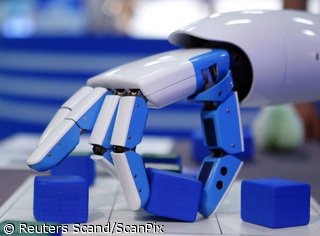When robots talk to each other, they're not generally using language as we think of it, with words to communicate both concrete and abstract concepts.
 When robots talk to each other, they're not generally using language as we think of it, with words to communicate both concrete and abstract concepts. Now Australian researchers are teaching a pair of robots to communicate linguistically like humans by inventing new spoken words, a lexicon that the roboticists can teach to other robots to generate an entirely new language.
When robots talk to each other, they're not generally using language as we think of it, with words to communicate both concrete and abstract concepts. Now Australian researchers are teaching a pair of robots to communicate linguistically like humans by inventing new spoken words, a lexicon that the roboticists can teach to other robots to generate an entirely new language.
Ruth Schulz and her colleagues at the University of Queensland and Queensland University of Technology call their robots the Lingodroids. The robots consist of a mobile platform equipped with a camera, laser range finder, and sonar for mapping and obstacle avoidance. The robots also carry a microphone and speakers for audible communication between them.
To understand the concept behind the project, consider a simplified case of how language might have developed. Let's say that all of a sudden you wake up somewhere with your memory completely wiped, not knowing English, Klingon, or any other language. And then you meet some other person who's in the exact same situation as you. What do you do?
What might very well end up happening is that you invent some random word to describe where you are right now, and then point at the ground and tell the word to the other person, establishing a connection between this new word and a place. And this is exactly what the Lingodroids do. If one of the robots finds itself in an unfamiliar area, it'll make up a word to describe it, choosing a random combination from a set of syllables. It then communicates that word to other robots that it meets, thereby defining the name of a place.
In the future, researchers hope to enable the Lingodroids to "talk" about even more elaborate concepts, like descriptions of how to get to a place or the accessibility of places on the map. Ultimately, techniques like this may help robots to communicate with each other more effectively, and may even enable novel ways for robots to talk to humans.